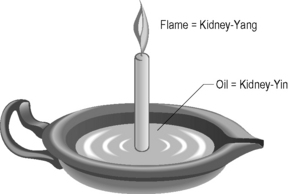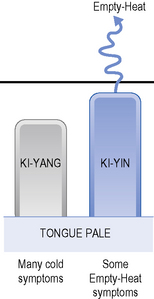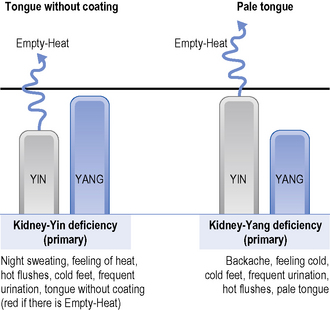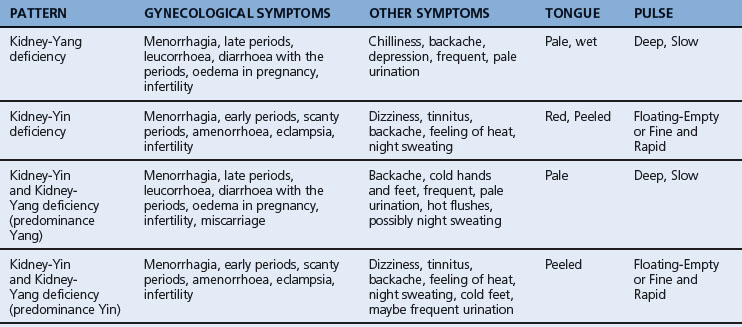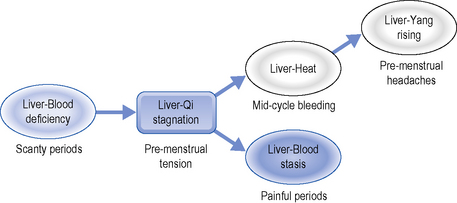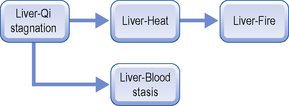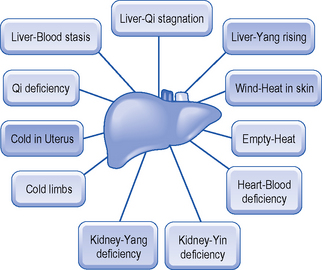CHAPTER 3 Women’s Pathology
Women’s pathology will be discussed under three main headings:
Pathology of the internal organs
Kidneys
Kidney deficiency
In women, a simultaneous deficiency of Kidney-Yin and Kidney-Yang is far more common after age 40. As Kidney-Yin and Kidney-Yang can both be deficient, in women this causes the very common situation when there are both Hot and Cold symptoms. This is because the Yin-deficient part of the Kidneys can give rise to Empty-Heat even if there is a predominance of Yang deficiency. For example, a woman may have backache, frequent, pale urination, swollen ankles, cold feet, Pale tongue (symptoms of Kidney-Yang deficiency) and hot flushes. Vice versa, a woman may suffer from backache, dizziness, night sweating, a Red-Peeled tongue, hot flushes (symptoms of Kidney-Yin deficiency), but cold feet and frequent urination. Figures 3.2 and 3.3 illustrate the above clinical situations when there is a deficiency of both Kidney-Yin and Kidney-Yang with a predominance of Kidney-Yang and Kidney-Yin respectively.
A few interesting observations can be made analysing the above list. First, all the women listed (bar one) are over 40, and the overwhelming majority are in their 40s. This is because, before 40, as the pathology is less long-standing, there is usually a clear-cut deficiency of either Kidney-Yang or Kidney-Yin. As the energy of the Kidney starts declining after 40 and it is often intertwined with a Blood pathology, a deficiency of Yang begins to induce a deficiency of Yin or vice versa, hence the overlapping of Kidney-Yin and Kidney-Yang deficiency (Fig. 3.4). After this time, in a woman over 60, whichever deficiency is primary will start to settle in and predominate over the other. Another observation that can be made is that the overlapping symptoms of Heat and Cold usually manifest in the feet with cold feet or hot feet at night, or in the face with a feeling of heat (the face does not usually have a feeling of cold).
As explained in the chapter on physiology (Ch. 2), the waxing and waning of Kidney-Yin and Kidney-Yang are responsible for the menstrual cycle. However, Kidney-Yin and Kidney-Yang are also interdependent and, because a deficiency of one often implies a deficiency of the other, often both are tonified, especially in the treatment of infertility. For example, Dr Lian Fang advocates adding Yin Yang Huo Herba Epimedii to Kidney-Yin tonics and Nu Zhen Zi Fructus Ligustri lucidi and Han Lian Cao Herba Ecliptae to Kidney-Yang tonics when treating infertility.1 Indeed, the two important formulae You Gui Wan Restoring the Right [Kidney] Pill and Zuo Gui Wan Restoring the Left [Kidney] Pill, which tonify Kidney-Yang and Kidney-Yin respectively, contain herbs that tonify Kidney-Yin and Kidney-Yang respectively. In fact, You Gui Wan (which tonifies Kidney-Yang) contains Gou Qi Zi Fructus Lycii which nourishes Kidney-Yin, and Zuo Gui Wan (which nourishes Kidney-Yin) contains Tu Si Zi Semen Cuscutae and Lu Jiao Jiao Colla Cornu Cervi which tonify Kidney-Yang.
Table 3.1 summarizes the Kidney patterns in gynecology.
Kidney deficiency
Liver
It is even possible to have five patterns. For example, Liver-Blood deficiency may lead to Liver-Qi stagnation and this may lead to Liver-Blood stasis. On the other hand, Qi stagnation may give rise to Heat and therefore Liver-Heat. On the other hand, Liver-Heat may also generate Liver-Yang rising (Fig. 3.5).
Liver-Qi stagnation
Closely related to Liver-Qi stagnation in gynecology is Liver-Yang rising, which is often associated with it. Liver-Yang rising typically causes headaches before or during the menses. Prolonged stagnation of Liver-Qi may also give rise to Liver-Heat and this to Liver-Fire as stagnant Qi may turn into Heat after a long period of time. Liver-Heat or Liver-Fire will cause a complex pathology; on the one hand, it may heat the Blood and cause Blood-Heat; on the other, Fire may injure Yin, eventually leading to Empty-Heat. Liver-Qi stagnation may also give rise to Liver-Blood stasis manifesting with painful periods with large, dark clots and dark menstrual blood (Fig. 3.6).
It is important to note that Liver-Qi and Liver-Blood represent the Yang and Yin aspect of the Liver sphere: they need to be harmonized, i.e. Yin should root and ‘embrace’ Yang. Very often, if Yin is deficient (i.e. Liver-Blood deficiency), it fails to restrain and root Yang (Liver-Qi) so that Liver-Qi stagnates. I therefore distinguish two types of Liver-Qi stagnation: one I call ‘primary’ and this derives from emotional stress and manifests with a pulse that is Wiry all over; the other I call ‘secondary’ and that is Liver-Qi stagnation deriving from Liver-Blood deficiency and due to a combination of emotional stress, diet and overwork (Table 3.2).
Table 3.2 Comparison of primary and secondary Liver-Qi stagnation
| Primary Liver-Qi stagnation | Secondary Liver-Qi stagnation |
|---|---|
| Emotional origin Arises ‘by itself’ | Arises as a consequence of or associated with Liver-Blood deficiency |
| Pronounced irritability, moodiness, depression | Aetiology emotional but also dietary and overwork |
| Pulse all Wiry | Not so much irritability, more depression and crying |
| Tongue normal or slightly Red sides | Pulse all Choppy, or Fine on the right and Wiry on the left or all Fine and very slightly Wiry |
| Yue Ju Wan Gardenia-Chuanxiong Pill | Tongue normal or Pale Xiao Yao San Free and Easy Wanderer Powder |
Liver-Qi stagnation
Liver-Blood deficiency
Liver-Blood deficiency can cause infertility, scanty periods, delayed cycle or amenorrhoea. Please note that ‘scanty period’ is not a symptom that would be reported by most women as they would be more alarmed by heavy rather than scanty periods. It is therefore important to ask about the duration of the period in days. This is discussed more at length in Chapter 5 on Diagnosis.
As explained in Chapter 2, although menstrual blood is Tian Gui and therefore not ‘Blood’ but ‘Water’, there is an overlap between Tian Gui and ‘normal Blood’ (see Fig. 2.29 in Ch. 2). This overlap takes place thanks to the Liver which partakes both of Tian Gui and of ‘ordinary Blood’. For this reason, when there are gynecological symptoms of Blood deficiency such as scanty periods or amenorrhoea, there often are also symptoms of deficiency of ‘ordinary Blood’, i.e. the Liver-Blood that nourishes the hair, eyes, skin, nails and sinews: these would be dry hair, blurred vision, dry skin, brittle nails and cramps.
One important characteristic of Liver-Blood deficiency is that it is often the origin of many other pathologies as evidenced by Figure 3.7. The following is a brief explanation of these pathologies with one or more representative prescriptions for each.
Liver-Blood stasis
Liver-Blood stasis is extremely common in women: this was explained in Chapter 2 on physiology. As their Lower Burner houses the Uterus which stores Blood, Blood easily stagnates in the lower abdomen. Indeed, I would go so far as saying that in chronic and complicated gynecological conditions, one should always suspect Blood stasis.
Although Liver-Qi stagnation plays a prominent role in modern Chinese books and also many Western ones, Liver-Blood stasis is far more important because it potentially gives rise to serious diseases such as endometriosis, cervical cancer, uterine cancer, polycystic ovary syndrome and myomas. Liver-Qi stagnation by itself cannot cause any of the above diseases. Moreover, although it may seem paradoxical, Liver-Blood stasis may even cause heavy menstrual bleeding. This happens because, when Liver-Blood stagnates, the blood vessels in the Uterus are obstructed by stagnant Blood. On the other hand, new Blood is being made all the time; this cannot take its place in the Uterus because it is obstructed by stagnant Blood, and it therefore spills out of the Uterus causing heavy menstrual bleeding (with dark blood and dark clots; see Fig. 3.8).
Stay updated, free articles. Join our Telegram channel

Full access? Get Clinical Tree


